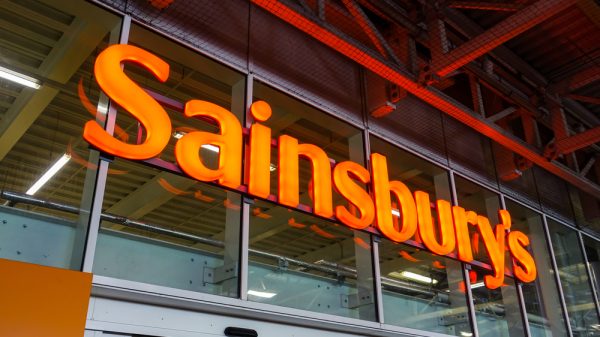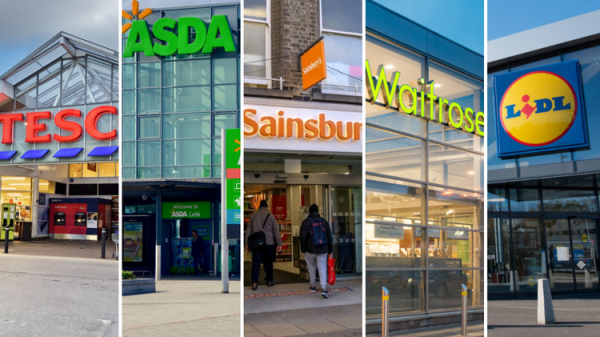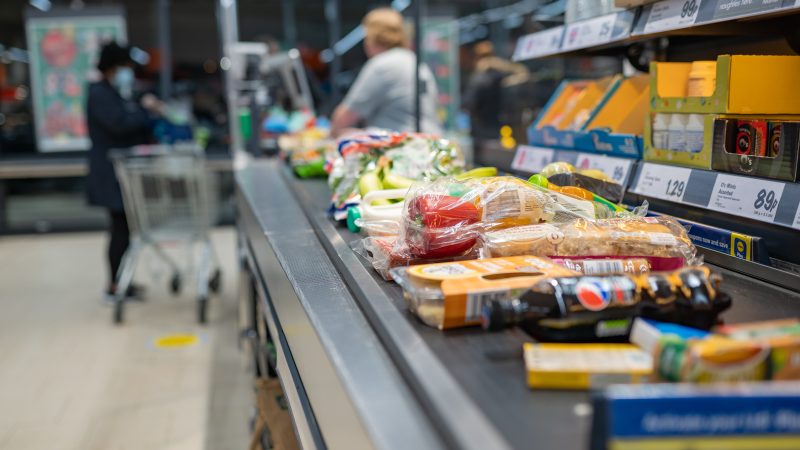The UK is facing an ongoing cost-of-living crisis with rising energy bills and household costs meaning consumers are tightening their belts; buying less, choosing cheaper brands and heading to discount retailers.
As a result of these cost-cutting measures, Aldi and Lidl have been climbing up the supermarket market share charts for the last few months, edging ever closer to the Big 4 – the UK’s four biggest supermarkets.
Tesco, Sainsbury’s, Asda and Morrisons have been untouchable for many years, but in the current post-pandemic landscape – which sees inflation at its highest level in 30 years and consumer confidence at an all-time low – all bets are off.
The latest take-home grocery figures from Kantar have revealed that Aldi’s sales have risen by 7.9% in the 12-week period to 12 June, taking its UK market share to 9% – just behind Morrisons’ 9.6%.
In the last five months, Aldi’s market share has grown by 1.2% and Morrisons has shrunk by 0.3%. Now with just 0.6% between them, the discount grocer is widely expected to overtake Morrisons to become the UK’s fourth most popular supermarket by June 2023.
READ MORE: Morrisons and Asda scrap plant-based sandwiches
Why is Morrisons losing market share to Aldi?
Aldi’s market share boost has been rapidly accelerated amid the ongoing cost-of-living crisis, which has resulted in more shoppers doing their weekly and top-up shops at the discount grocers.
Lidl has also benefitted from this move and has now been named the UK’s cheapest supermarket for the past four months in a row.
According to GlobalData’s food and grocery analyst Amira Freyer-Elegendy, it’s not a matter of whether Aldi will take over Morrisons, but when.
She told Grocery Gazette: “We do not expect Aldi to overtake Morrisons this year, it is more likely to happen next year.
“While we expect Morrisons to feel the squeeze in 2022 and underperform compared to the discounters and the likes of Tesco, the gains Aldi is forecast to make this year, aided by customer acquisition opportunities and stronger customer loyalty, will not be enough to boost it from fifth to fourth position in 2022.”
Where does Aldi fit in the UK grocery landscape?
The German discount grocer opened its first British branch in Birmingham in 1990, with Lidl following four years later.
At first, shoppers turned their noses up at these new discounters, but as they have gradually drawn in more middle-class shoppers, thanks to cheaper prices, eye-catching promotions and a strategy of locating new stores in more areas.
Aldi now has 950 sites across the UK, compared to about 500 Morrisons stores.
IGD senior business analyst, Nick Gladding, believes that, given the present rate of progress of Aldi’s market share, “it’s certainly looking like Aldi will overtake Morrisons in the near future”.
“Aldi’s growth is very much driven by new store openings and the discounter is broadly on track to be running 1,000 stores in the UK this year and 1,200 by 2025,” he said.
“Clearly, the cost-of-living crisis plays to Aldi’s strengths, with more shoppers needing to economise to offset increasing fuel and energy costs as well as general price inflation. Aldi has made great progress offering products that are good quality and relevant and continues to grow sales, despite other retailers’ price matching schemes.”
Aldi’s presence on the UK scene is a clear threat to many of the UK’s traditional supermarkets. Big 4 grocers Sainsbury’s and Tesco have both started to price match their products to Aldi prices in a bid to keep hold of their customers.
The supermarkets are currently matching the prices of over 200 products, even going as far as to increase an item’s listing when the price goes up in Aldi stores.
READ MORE: Aldi adds bowel cancer signs and symptoms on toilet roll packs
How can Morrisons fight back?
Morrisons has been slowly losing its UK market share for some time, with much (although not all) of that business going to the discount grocers.
Speaking to Grocery Gazette earlier this year NielsenIQ’s head of retail and business insight Mike Watkins said there had been a “structural change in the retail landscape over the last decade”.
“Aldi and Lidl opened new stores, which meant that the market share of the Big 4 fell from 63% in 2013 to 54% at the end of 2021.”
Morrisons has a few weapons up its sleeve if it decides to focus on fighting back to retain its place in the Big 4 grocers. The recent McColl’s acquisition and ongoing grocery partnerships with Q-commerce company Deliveroo and Amazon Fresh might ultimately be key to reestablishing the retailer’s market share.
“The big opportunity for Morrisons lies beyond its supermarkets,” said Gladding.
“Its close partnership with Amazon offers much potential for growth while its agreement to acquire McColl’s and its 1,100 strong store portfolio will greatly extend Morrisons’ reach into the convenience channel.
“Market Kitchen, Morrisons innovative and expanding freshly prepared foodservice concept, is another asset not captured within its market share figures.”
Aldi’s lack of loyalty scheme is also a weakness which could be exploited.
Earlier this year, Morrisons unveiled its newest loyalty scheme and app, which offers customers instant money off their shopping.
The new My Morrisons: Make Good Things Happen scheme converts all savings into pounds which will be available to spend immediately so customers do not need to save up points or wait for vouchers.
Shopfloor Insights founder Bryan Roberts told RetailWeek that in an inflationary environment, he believes “loyalty is going to become increasingly important for customers.”
Aldi vs Morrisons: the final verdict
Analysts are almost unanimous in their assertions that Morrisons will be taking a step back from the Big 4 by this time next year, making way for Aldi to take its spot.
“Morrisons is likely to continue to be outpaced as its new owners are focused on boosting profitability over sales growth,” Gladding continued.
“While the retailer has cost advantages that allow it to be very competitive on fresh produce, it is hard for Morrisons to offer similarly attractive prices on brands as it lacks the same scale as the other ‘big four’ retailers.”
Hargreaves Lansdown analyst Susannah Streeter agreed that the discount grocers are “snatching” customers from Morrisons and Asda, which both “seem to be falling behind in the competition to cut prices since being bought out”.
“They went on a price offensive in April, but as they face an ever-tighter squeeze with costs mounting as they carry heavy debt loads, it’s going to be a lot harder to find room for fresh rounds of price cuts,” she added.
Shore Capital retail analyst Clive Black said simply: “It’s not fanciful to suggest that by 2023 Aldi will be the fourth-biggest grocer in the UK”.
It is almost certain that Aldi will be stepping on Morrisons toes at some point in the next year unless some fairly dramatic changes are made to the UK grocery landscape.
With inflation continuing to rocket and prices continuing to rise as suppliers battle with supply chain difficulties amid an increasingly competitive market, it looks safe to say Morrisons will be kissing goodbye to its Big 4 position. The only real question is when.










